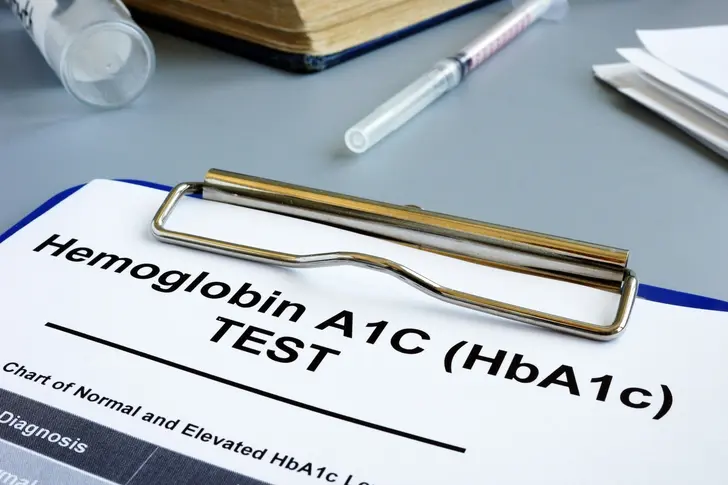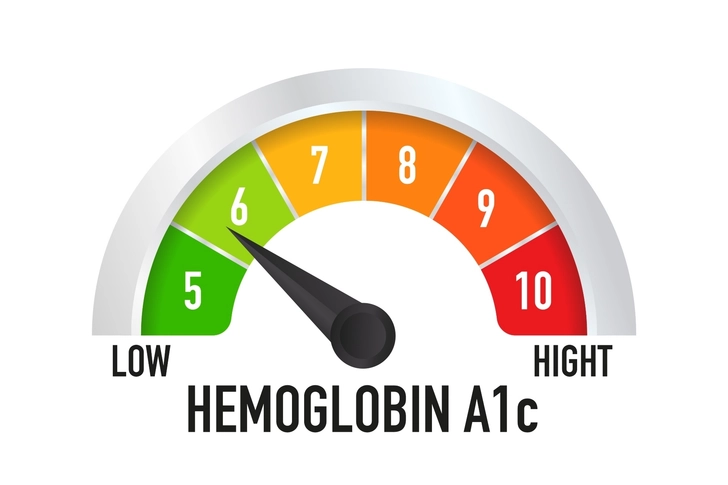- Overview & Types
- Symptoms & Diagnosis
- Treatment
- Living With
- Related Conditions
- Type 2 Diabetes
- Type 1 Diabetes
- Gestational Diabetes
- Appointment Prep
- View Full Guide
Why Your A1c Level Matters and How to Lower It


What Is A1c and Why Does It Matter?
A1c, also known as hemoglobin A1c or HbA1c, is a blood test that measures your average blood sugar levels over the past two to three months. It provides a longer-term view of blood sugar control compared to daily glucose monitoring and helps predict your risk of diabetes complications. Higher A1c levels mean you have a greater risk of serious health issues such as heart disease, kidney problems, and nerve damage.

Understanding A1c Percentages
A1c is given as a percentage. For people without diabetes, a normal A1c is below 5.7%. Prediabetes is diagnosed when A1c is between 5.7% and 6.4%. A level of 6.5% or higher means you have diabetes. For most adults with diabetes, the American Diabetes Association recommends an A1c target of less than 7%. But your doctor may set a different target based on your age, how long you've had diabetes, and other health conditions.

The Benefits of Lowering Your A1c
Even small improvements in your A1c can make a big difference in your long-term health. Research shows that each 1% drop in A1c lowers the risk of kidney, eye, and nerve problems by 40%. Improved A1c levels can also reduce your chances of heart attacks and strokes. As a bonus, better blood sugar control often leads to more energy and an improved mood.

Watch Your Carb Intake
Carbohydrates have the biggest impact on blood sugar levels. Learn to count carbs and understand portion sizes. Focus on complex carbohydrates like whole grains, legumes, and vegetables, which are digested more slowly and have less impact on blood sugar. Limit simple carbs like sugary drinks, white bread, and sweets. Consider working with a registered dietitian to create a personalized meal plan that balances your carb intake with your medication and activity levels.

Eat a Balanced Diet
A balanced eating plan can help you manage your A1c. Aim for regular meals that include a mix of carbohydrates, lean proteins, and healthy fats. This combination helps slow down digestion and prevents rapid spikes in blood sugar. Include plenty of fiber-rich foods, which can help improve blood sugar control. Consider the plate method: fill half your plate with non-starchy vegetables, a quarter with lean protein, and a quarter with whole grains or starchy vegetables. Don't skip meals, as this can lead to poor blood sugar control.

Manage Your Weight
Maintaining a healthy weight or losing weight can significantly improve your A1c. If you're overweight, losing just 10-15 pounds can make a noticeable difference in your A1c. Aim for gradual, steady weight loss rather than a crash diet. Combine a balanced eating plan with regular physical activity. Talk to your doctor about setting realistic weight loss goals and strategies.

Rethink Your Exercise Plan
Exercise helps your body use insulin more effectively and can lower blood sugar levels for hours after you stop moving. Aim for at least 150 minutes of moderate-intensity aerobic activity per week, spread over at least three days. Include strength training exercises at least twice a week. Start slowly and gradually increase your activity level. Find activities you enjoy, whether it's walking, swimming, cycling, or dancing. Remember to check your blood sugar before, during, and after exercise, especially when starting a new routine.

Be Wary of Supplement Claims
While some supplements claim to lower blood sugar, be cautious about these promises. Many lack solid scientific evidence, and some can interact with diabetes medications or cause side effects. Talk to your doctor before taking supplements. If you do choose to use supplements, look for products that are third-party tested for quality and purity. Supplements should complement, not replace medication, diet, and exercise.
PHOTO CREDITS:
Slide 1 - iStock/Getty Images
Slide 2 - StudioGraphic/Getty Images
Slide 3 - Peakstock/Shutterstock
Slide 4 - Sultan Amir/Shutterstock
Slide 5 - iStock/Getty Images
Slide 6 - PowerUp/Shutterstock
Slide 7 - Andri wahyudi/Shutterstock
Slide 8 - Kmpzzz/Shutterstock
SOURCES:
Lab Tests Online: "Hemoglobin A1C."
National Institute of Diabetes and Digestive and Kidney Diseases: "The A1C Test & Diabetes."
American Diabetes Association: "A1C and eAG."
Clinical Diabetes: "Your A1C Results: What Do They Mean?"
Mayo Clinic: "A1C test: Overview," Mayo Clinic: "A1C test: Why it's done," "A1C test: Results."
UpToDate: "Patient education: Diabetes mellitus type 2: Overview (Beyond the Basics)."
Mayo Clinic: “A1C Test,” “Hyperglycemia in Diabetes,” “Diabetes Diet: Create Your Healthy Eating Plan.”
Merck Manual: “Formation of Blood Cells.”
National Institutes of Health: “The A1C Test and Diabetes.”
Harvard T.H. Chan School of Public Health: “Carbohydrates and Blood Sugar.”
Joslin Diabetes Center: “Key to Success: Portion Control.”
Pakistan Journal of Medical Sciences: “Effect of Vitamin D Supplementation on Reduction in Levels of HbA1 in Patients Recently Diagnosed with Type 2 Diabetes Mellitus Having Asymptomatic Vitamin D Deficiency.”
Utah.gov: “How Can You Lower Your A1C To a Healthy Number?”
Diabetology and Metabolic Syndrome: “Resistance Exercise Training Lowers HbA1c More Than Aerobic Training in Adults With Type 2 Diabetes.”
American Diabetes Association: “Medication Management: What Are My Options?”
American Diabetes Association: “A1C Test,” “A1C and eAG.”
Diabetes Care: “2. Classification and Diagnosis of Diabetes: Standards of Care in Diabetes—2023.”
National Institute of Diabetes and Digestive and Kidney Diseases: “The A1C Test and Diabetes.”
Mayo Clinic: “Hemoglobin test,” “Diabetes management: How lifestyle, daily routine affect blood sugar.”
Cleveland Clinic: “Blood Glucose (Sugar) Test,” “A1C,” “Low Hemoglobin,” “Hemoglobin Test.”
CDC: “All About Your A1C,” “Diabetes and Nerve Damage.”
U.S. Preventive Services Task Force: “Prediabetes and Type 2 Diabetes: Screening.”
Medicaid: “Comprehensive Diabetes Care: Hemoglobin A1c (HbA1c) Poor Control (>9.0%): Ages 18 to 75.”
Harvard Medical School: “Rethinking A1c goals for type 2 diabetes.”
University of Florida Health: “Some in-home tests for average blood sugar levels less accurate than traditional method.”
Diabetes Technology & Therapeutics: “Accuracy of Three Commercial Home-Use Hemoglobin A1c Tests.”
UCSF Benioff Children's Hospitals: “A1C Test.”
Mount Sinai: “Iron deficiency anemia,” “Hemoglobin.”
University of Utah: “Hemoglobin Disorders.”
StatPearls: “Physiology, Oxygen Transport.”
American Red Cross: “Physiologic and Demographic Factors that Influence Hemoglobin and Platelet Levels.”
ASH Clinical News: “At-Home Hemoglobin Test Kit for Anemia Receives Approval.”
UCI Health: “Hemoglobin and Your Health.”